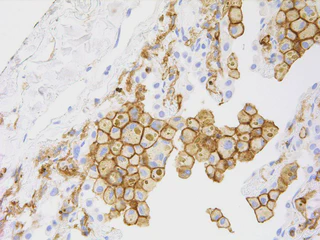Melittin Induced G1 Cell Cycle Arrest and Apoptosis in Chago-K1 Human Bronchogenic Carcinoma Cells and Inhibited the Differentiation of THP-1 Cells into Tumour-Associated Macrophages
 Image credit: Jurajb101 via Wikimedia Commons
Image credit: Jurajb101 via Wikimedia CommonsBackground: Bronchogenic carcinoma (lung cancer) is one of the leading causes of death. Although many compounds isolated from natural products have been used to treat it, drug resistance is a serious problem, and alternative anti-cancer drugs are required. Here, melittin from Apis mellifera venom was used, and its effects on bronchogenic carcinoma cell proliferation and tumour-associated macrophage differentiation were evaluated.
Methods: The half maximal inhibitory concentration (IC50) of melittin was measured by MTT. Cell death was observed by annexin V and propidium iodide (PI) co-staining followed by flow cytometry. Cell cycle arrest was revealed by PI staining and flow cytometry. To investigate the tumour microenvironment, differentiation of circulating monocytes (THP-1) into tumour-associated macrophages (TAMs) was assayed by sandwich-ELISA and interleukin (IL)-10 levels were determined. Cell proliferation and migration was observed by flat plate colony formation. Secretion of vascular endothelial growth factor (VEGF) was detected by ELISA. The change in expression levels of CatS, Bcl-2, and MADD was measured by quantitative RT-PCR.
Results: Melittin was significantly more cytotoxic (p < 0.01) to human bronchogenic carcinoma cells (ChaGo-K1) than to the control human lung fibroblasts (Wi-38) cells. At 2.5 μM, melittin caused ChaGo-K1 cells to undergo apoptosis and cell cycle arrest at the G1 phase. The IL-10 levels showed that melittin significantly inhibited the differentiation of THP-1 cells into TAMs (p < 0.05) and reduced the number of colonies formed in the treated ChaGo-K1 cells compared to the untreated cells. However, melittin did not affect angiogenesis in ChaGo-K1 cells. Unlike MADD, Bcl-2 was up-regulated significantly (p < 0.05) in melittin-treated ChaGo-K1 cells.
Conclusion: Melittin can be used as an alternative agent for lung cancer treatment because of its cytotoxicity against ChaGo-K1 cells and the inhibition of differentiation of THP-1 cells into TAMs.
Lay summary
Lung cancers are resistant to many drugs. Bee venom contains a protein called melittin. We want to know if it kills lung cancer cells and stops macrophages – a type of white blood cell – from changing cell type. Macrophages are important as it changes behaviour in lung cancer.
We tested melittin on:
- how well it kills lung cancer cells,
- how well it stops lung cancer cells from dividing,
- how it affects macrophages moving and changing cell type,
- how it affects the cancer producing a chemical that makes blood vessels grow towards it, and
- how it affects the levels of RNAs that show the activity of lung cancer cells.
We found that melittin does indeed kill cancer cells and stop them from dividing, if we use a particular concentration. Melittin also stops macrophages from changing cell type. However, melittin does not change how well the cancer tells the body to make new blood vessels. We also saw how melittin change how lung cancer cells produce RNAs that instruct processes in the cell.
So, we think doctors can use melittin to treat lung cancer.
My role
I performed some experiments. I added melittin in various concentrations to see which concentration kills the lung cancer cells. This work became figure 5 in the paper. I also performed RT-qPCR to detect RNAs – this is the same technique people use to perform PCR tests to detect COVID-19.